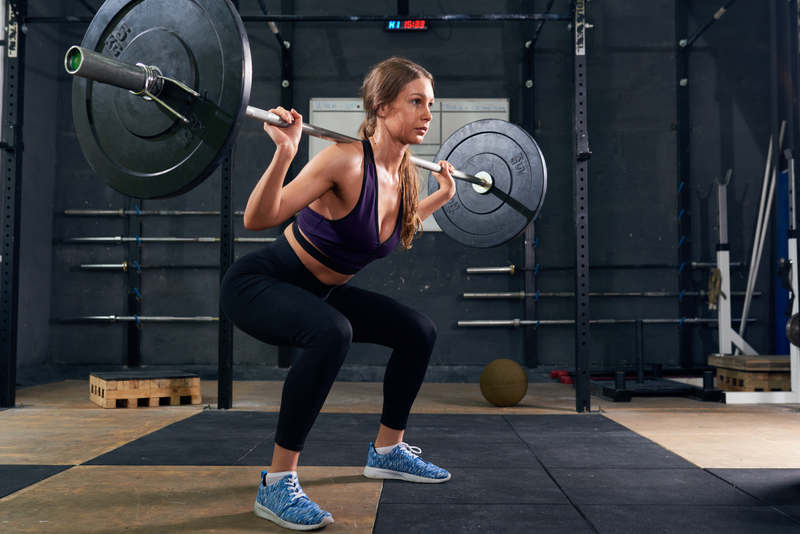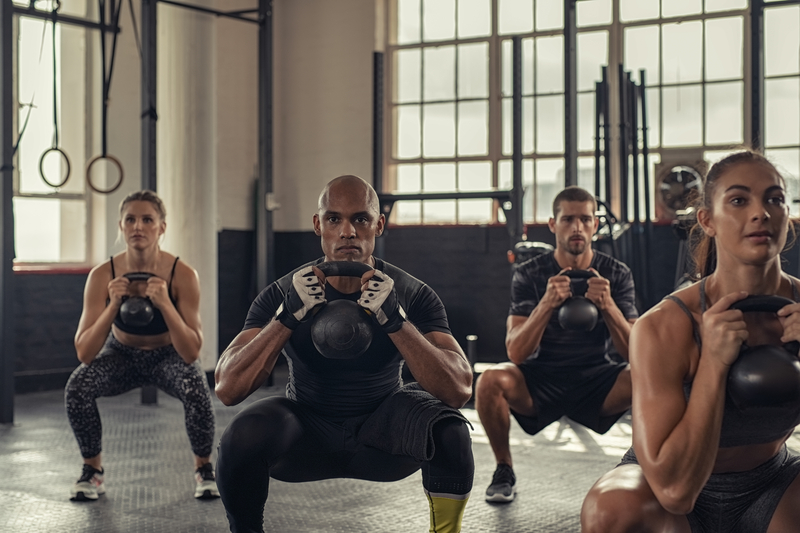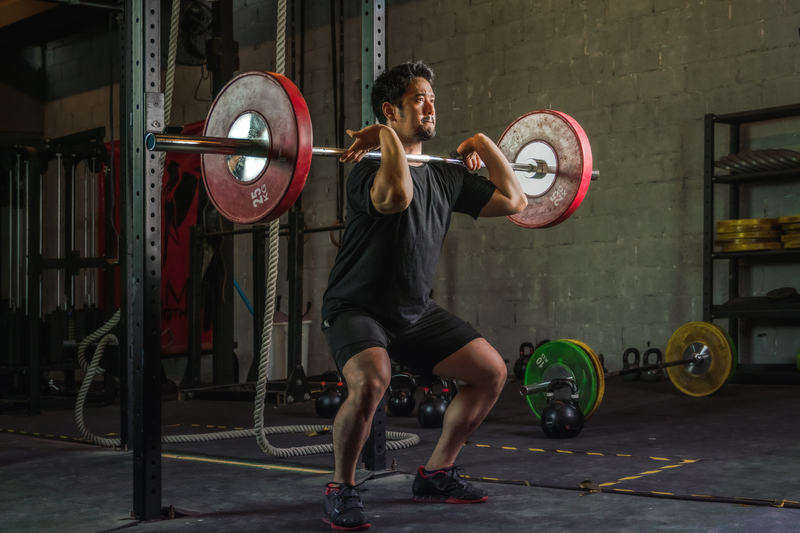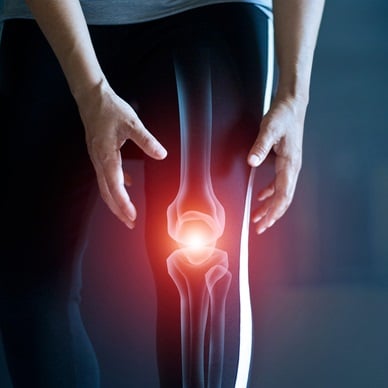6 Best Squat Variations to Maximize Your Leg Days

If you want to get the most out of your leg days, you’ll want to include a number of squat variations. Using different types of squats can challenge and strengthen your legs from multiple angles and give you an overall more inclusive workout over time. Not only do squats work a variety of muscles in the body, they are a tough exercise that will also help you build metabolically active muscle and burn lots of extra calories.
What is a Squat?
A squat is an exercise that works mostly lower body muscles. Essentially, you start in a standing position and then bend at the knees while kicking your hips back and down (as if you were lowering yourself to sit on a seat). Keeping your feet flat on the floor and your chest, head, and torso upright, continue downward movement until your knees are fully bent. Once in the “squat” position, push back up through your heels until fully upright, using your legs, hips, and glutes to move your body.
Muscles and Squat Variations
Which muscles do you work when you do squats? You might be tempted to think it’s just the “legs” that get worked, but what does that mean, exactly, and is it true?
In actuality, when you squat, you work a lot more than “just the legs.” Your glutes and hips engage as well as your core and lower back. That said, squats also heavily work the quadriceps (front of your legs) and the hamstrings (back of your legs). Some squat variations even work the calves and/or upper body. Virtually all squats work overall legs and core, regardless of style.
6 Best Squat Variations
When doing squats, it can be fun (and beneficial) to try different squat variations. This will enable you to focus on different areas of the lower body and switch up your workouts so you can keep your body guessing and make the most progress from your training.
Wider squats tend to focus more on glutes and hamstrings while narrow foot placement on squats will work more of the quadriceps. Always ensure that your knees track over your toes to avoid injury. Keep your upper body and head upright and take it slowly. Good form is paramount.
1. The Bodyweight Squat

Main muscle focus: quadriceps, hamstrings, glutes
Benefits: easy to do, requires no equipment, great for beginners, easy on the body
How to do it: This type of squat is done with just your body weight. Start by standing with your feet about hip-width apart. Place your hands on your hips or straight out in front of you and start to bend at the knees. While bending, simultaneously kick your hips back behind you until your knees are either fully bent or your thighs are parallel with the ground (see how you feel best). Keep your feet flat on the ground. When in the full squat position, push back up to standing by straightening your knees and pushing your hips forward as you stand.
2. Barbell Squats

Main muscle focus: quads, hamstrings, and glutes
Benefits: It’s basic but has huge benefits—strengthening your overall lower body, engaging your core, promoting good balance and flexibility, and burning tons of calories
How to do it: This tried-and-true squat variation involves you and a barbell. Start with your feet about hip-width apart. Place a barbell behind your head along your upper back and traps (not on the neck) and grab it with your palms facing forward. Kick back at the hips as you bend your knees, lowering your torso while staying upright, shoulder blades back, and elbows out. Once in a squat position, push back up through your heels to start and squeeze the leg muscles at the top of the movement.
3. Goblet Squats

Main muscle focus: mainly glutes, but also hamstrings, quads, arms, shoulders, back, and core
Benefits: This can be considered a full-body workout as it uses so many muscles but also removes load from the back
How to do it: Start with your feet in a very wide stance, toes pointed outward. Grasp a dumbbell in the vertical position with both hands in front of you or, alternatively, you can use a kettlebell. Holding the weight near your chest, kick your hips back as you bend at the knees, allowing your knees to travel the path of your outwardly pointed feet. Pause at the bottom of the movement and then push back to upright by squeezing the glutes as you straighten your legs and bring your hips forward.
LIMITED TIME OFFER: Get Ageless Turmeric, Our Highly-Bioavailable Turmeric & Ginger Supplement, As Low As $14
4. Bulgarian Split Squats

Main muscle focus: These squat variations focus on one leg at a time.
Benefits: Can isolate each leg, protects your lower back, and forces you to improve your balancing ability
How to do it: Start by standing a few feet in front of a bench, chair, or couch. Pick up your left foot, bend at the knee, and place the top of your foot onto the bench. You can do this with or without dumbbells in your hands. If you’re just starting out, try it first without weight.
Next, bend your right knee to bring your body down into a squat position while keeping your head and torso upright. Once in the full squat position, push back up to standing with your right heel. Repeat the squat motion ten times on the right before switching sides and doing the movement on the left.
5. Box Squats
Main muscle focus: back, lower back, spinal erectors, hamstrings, glutes
Benefits: Allows you to sit back further than you would with a regular squat, which activates different muscles, also takes away all momentum, forcing you to do all the work
How to do it: Start by placing a bench or box about a foot behind you. Sit back to ensure that your hips will connect with the edge of the bench when squatting down. Next, grab either a dumbbell in each hand or place a barbell across your upper back and traps. Bend at the knees as you kick your hips back behind you, squatting down until your butt hits the bench. Pause and then power back up to standing by thrusting your hips forward and straightening your legs.
6. Front Squats

Main muscle focus: quadriceps
Benefits: Easier on the upper and lower back, improves mobility and flexibility
How to do it: Start with your feet a little wider than hip-width apart. Balance a barbell along the top of your chest and shoulders. You can either bend your palms back to grip the bar with your fingertips or cross your arms in front of you to support the bar. Squat down as you normally would, taking care to balance and not tip forward as you squat down. Once at the bottom of the movement, straighten your legs, push your hips forward, and use your quadriceps to bring your body back to an upright position.




 US Doctor: "Eating This Every Day Can Snap You Into Ketosis"
US Doctor: "Eating This Every Day Can Snap You Into Ketosis" 3 Key Nutrients to Help Lubricate Your "Tin Man" Joints
3 Key Nutrients to Help Lubricate Your "Tin Man" Joints AVOID Plant-Based Protein Powders (unless...)
AVOID Plant-Based Protein Powders (unless...)

